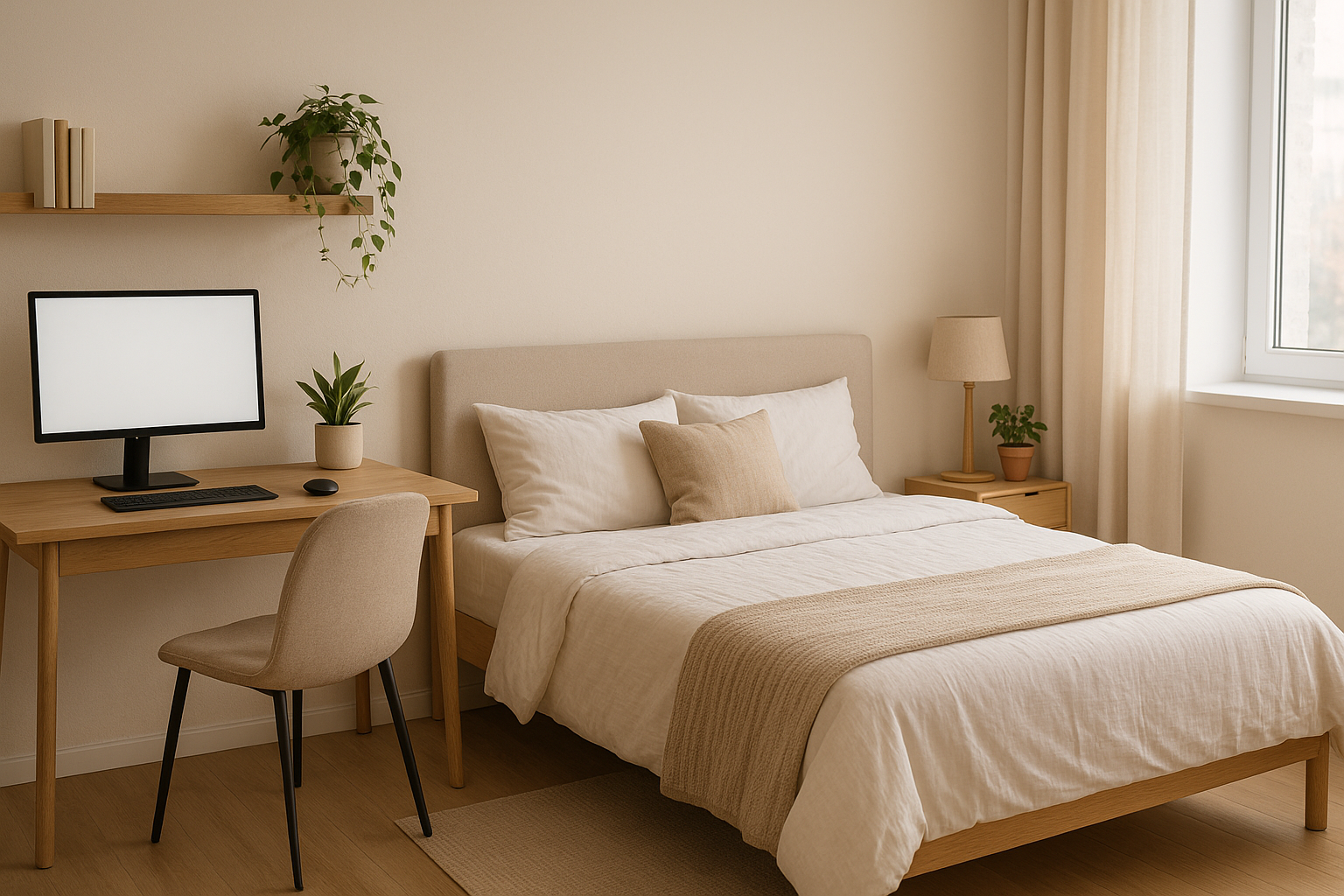Combining your bedroom with a home office is often a necessity in small apartments. But how can you balance rest and productivity in one room without letting one interfere with the other?
The key lies in intentional design, smart zoning, and furniture that works double duty. In this article, you’ll learn how to create a practical, stylish, and peaceful bedroom-office hybrid—where you can sleep well and work efficiently.
Why the Bedroom Is a Logical Place for a Home Office
Many small apartments lack a dedicated office space, so people often use:
- The living room
- The kitchen table
- Or the bedroom
Among these, the bedroom is often the quietest and most private space—ideal for focused work. But unlike an office, it also needs to remain a sanctuary for rest.
That means your home office must be designed in a way that supports both functions—and helps you mentally switch between them.
Step 1: Define Your Priorities
Start by asking:
- How many hours do you work from home?
- Do you work full-time, part-time, or occasionally?
- Do you need a large monitor or just a laptop?
- Is video calling part of your routine?
The answers will determine how much space and structure your workspace will need inside your bedroom.
Step 2: Choose the Right Location in the Room
Even in a small bedroom, placement matters. Your desk should be away from the bed if possible, to create physical and psychological separation.
Best locations:
- Next to or in front of a window (for natural light)
- In a corner to reduce distractions
- Inside an alcove or nook, if available
- Opposite the bed to reduce work-related stress while lying down
Avoid placing your desk directly beside your bed unless absolutely necessary. If you must, use a small divider or curtain.
Step 3: Use Space-Saving Furniture
The bedroom isn’t the place for bulky office furniture. Choose pieces that are streamlined, neutral, and multipurpose.
Ideal furniture:
- Wall-mounted desks or fold-down work surfaces
- Slim writing desks with drawers
- Corner desks that don’t dominate the room
- Floating shelves for vertical storage
- A rolling chair that can tuck completely under the desk
Bonus: A chair that matches your bedroom decor helps the office area blend in visually.
Step 4: Establish Zones Visually
You can subtly separate your workspace from the rest area using design elements instead of walls.
Smart zoning tips:
- Use a rug under the desk to define the office zone
- Paint or wallpaper the wall behind your desk in a contrasting tone
- Hang a curtain, screen, or open bookshelf as a divider
- Use separate lighting for each area
These techniques help you mentally “arrive at work” and “leave the office” without leaving your room.
Step 5: Keep the Office Area Clutter-Free
Visual noise disrupts both productivity and sleep. Your desk should be minimalist and clean, especially before bedtime.
Tips for tidy workspaces:
- Use cord organizers or go wireless
- Store supplies in drawers or decorative boxes
- Limit desktop items to the essentials
- Add a small plant or lamp for personality
At the end of the day, do a quick “desk reset” to keep the area ready for the next morning—and avoid bringing work stress into your sleep zone.
Step 6: Use Lighting to Create Mood and FunctionLighting plays a key role in maintaining the balance between work and rest.
During the day:
- Use natural light as much as possible
- Supplement with a desk lamp for focused tasks
In the evening:
- Switch to warm ambient lights to wind down
- Use a dimmable bedside lamp or smart bulbs to adjust mood
- Avoid harsh overhead lights that feel too “office-like”
Pro tip: Place your computer monitor so it doesn’t glow directly toward your bed.
Step 7: Choose a Desk That Disappears
If you want your room to feel like a bedroom and not a workspace, choose a desk that blends in—or even hides away.
Stylish solutions:
- A fold-down desk that looks like a cabinet when closed
- A dressing table that doubles as a work desk
- A Murphy bed wall unit with built-in desk
- A writing desk in the same wood tone as your other bedroom furniture
Avoid flashy “office furniture” that disrupts the harmony of your space.
Step 8: Minimize Tech ClutterTech clutter is a common problem in home offices—especially in the bedroom, where you want peace.Simplify your setup:
- Use a laptop stand and wireless accessories
- Hide chargers in cable boxes
- Install a power strip under the desk
- Mount your monitor if possible
If you use a desktop computer, consider setting it up so it’s out of sight from your bed to maintain a restful environment.
Step 9: Add Natural Elements
A little greenery can go a long way in softening the boundary between work and rest. Plants improve air quality and create a calming atmosphere.
Best plants for bedrooms:
- Snake plant
- Peace lily
- Pothos
- ZZ plant
- Lavender (in natural light)
Keep it simple—one or two plants are enough.
Step 10: Make It a Place You Enjoy
Your home office doesn’t have to feel corporate. Choose decor that matches the calming energy of your bedroom.
Add personal touches:
- Artwork or photos above the desk
- A beautiful mug for pens or tea
- A scented candle or diffuser
- Matching textiles for desk chair cushions or throws
These finishing touches create a space that feels uniquely yours—and helps you enjoy your time at the desk.
Final Thoughts: Work Hard, Sleep Well
Designing a home office in your bedroom is all about balance. It needs to support productivity during work hours and promote relaxation afterward. By choosing minimalist furniture, defining zones, and decorating with intention, you can create a space that supports both focus and comfort.
When your office setup works in harmony with your bedroom, your day flows better—and so does your night. And in a small apartment, that balance is the real definition of success.

